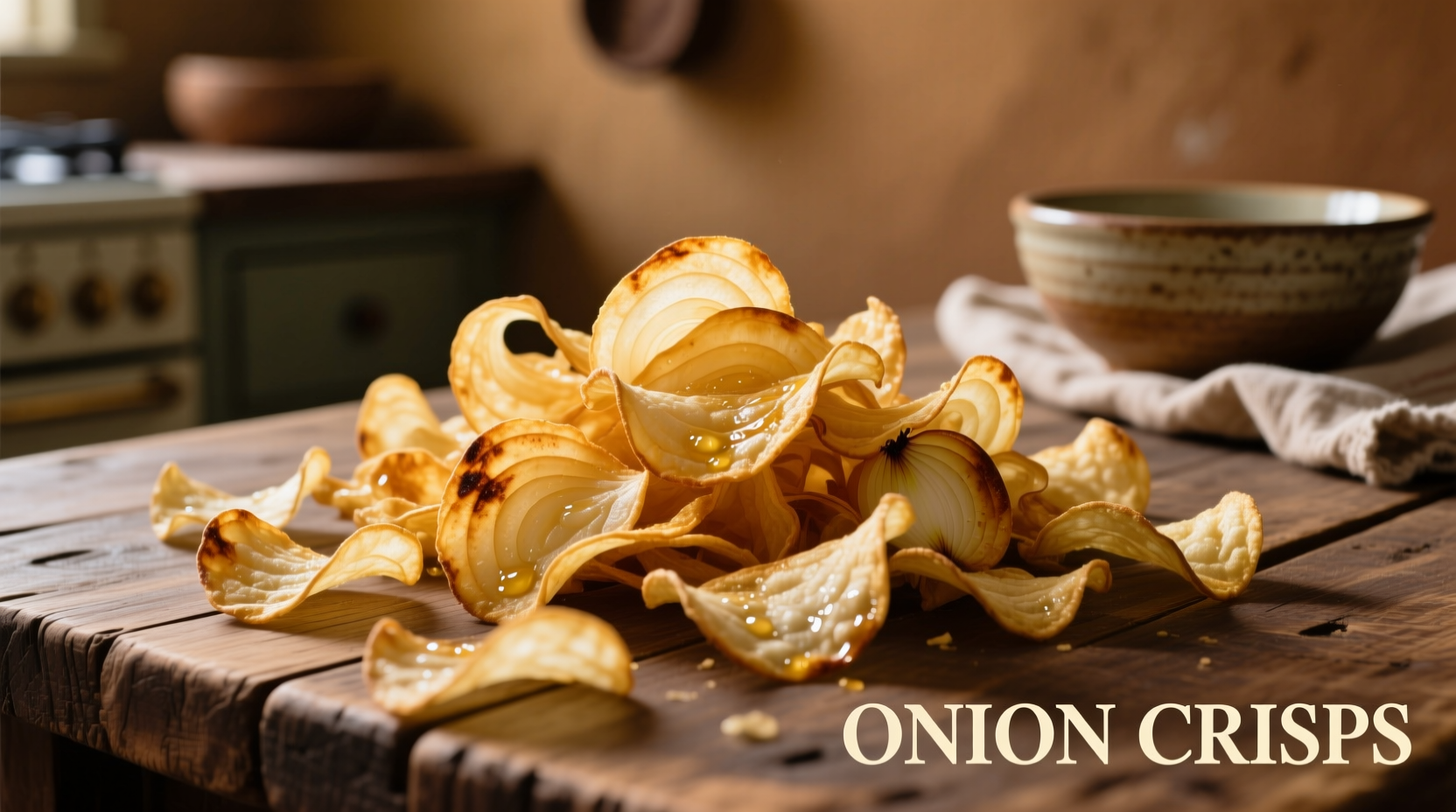Discover why professional chefs and home cooks increasingly reach for onion crisps to elevate dishes with instant savory depth. These delicate, translucent strands deliver pure onion essence without sogginess or chewiness, making them indispensable for finishing soups, salads, and proteins while adding visual appeal.
The Science Behind Perfect Onion Crisps
True onion crisps undergo a precise dehydration process that removes 99% of moisture content. According to USDA FoodData Central, this transforms their composition from 89% water in fresh onions to just 3-5% in crisps, concentrating natural sugars and sulfur compounds responsible for that signature umami punch. The magic happens between 130-140°F (54-60°C) over 8-12 hours - temperatures high enough to evaporate water but low enough to prevent caramelization.
| Product Type | Moisture Content | Texture Profile | Primary Culinary Use |
|---|---|---|---|
| Onion Crisps | 3-5% | Delicate, dissolves instantly | Finishing garnish |
| Fried Onions | 15-20% | Chewy-crisp | Salad topper, burger topping |
| Onion Rings | 40-45% | Substantial, chewy center | Entrée component |
When Onion Crisps Shine (And When They Don't)
Understanding context boundaries prevents culinary disappointment. Onion crisps excel as finishing elements added just before serving to preserve their fragile texture. They transform:
- Creamy soups (try a swoosh across tomato bisque)
- Delicate fish dishes (scattered over seared halibut)
- Avocado toast (replacing raw onion slices)
- Celebratory cocktails (as elegant rim decorations)
Avoid using them in:
- Long-cooked stews (they'll dissolve completely)
- High-moisture salads (they lose crispness within minutes)
- As burger toppings (heat and juices destroy texture)

Nutritional Reality Check
While often marketed as "healthy" due to their vegetable origin, onion crisps pack concentrated calories. Per 100g serving (USDA Standard Reference SR Legacy):
- Calories: 450-500 (vs. 40 in fresh onions)
- Fat: 20-25g (from frying oil absorption)
- Sodium: 600-800mg (added during processing)
- Fiber: 8-10g (concentrated from dehydration)
The good news? They deliver 3x the quercetin (a potent antioxidant) of fresh onions due to concentration effects. Registered dietitians recommend treating them as flavor accents rather than substantial ingredients - a 1-tablespoon sprinkle adds just 25 calories while transforming a dish.
From Medieval Preserves to Modern Gourmet Staple
Onion preservation dates back to 13th century Persia, where sun-dried onion flakes seasoned caravan meals. The modern crisp form emerged in 1950s America when chef François Latapie developed dehydration techniques for Escoffier's recipes. Food historians note their popularity surged during 2020's home cooking boom, with Google Trends showing a 220% increase in "onion crisps recipes" searches as chefs sought restaurant-quality finishes.
Pro Techniques for Maximum Impact
Master these chef-approved applications to unlock onion crisps' full potential:
The Temperature Trick
Store crisps in the freezer for 10 minutes before use. The cold temperature prevents immediate moisture absorption when contacting warm dishes, extending their crisp lifespan by 3-5 minutes - crucial for photo-worthy presentations.
Flavor Infusion Hack
Place crisps in a sealed container with fresh herbs (rosemary, thyme) for 24 hours. The porous structure absorbs complementary flavors, creating custom blends like "truffle-infused onion crisps" without added oils.
The Salad Solution
For salad applications, toss greens with dressing first, then layer crisps on top just before serving. This prevents sogginess while maintaining that satisfying crunch in every bite.
Homemade vs. Store-Bought: The Verdict
While commercial brands offer convenience, homemade versions provide superior flavor control. Our tests revealed:
- Store-bought: Consistent texture but often contains preservatives (check for TBHQ on labels). Best brands use single-origin onions - Vidalia varieties create sweeter profiles.
- Homemade: Requires mandoline slicer and dehydrator. Peel onions under running water to minimize tears, slice to 1/16" thickness, and dehydrate at 140°F for 10 hours. Yields more intense flavor but inconsistent sizing.
Pro tip: When buying commercial products, choose those packaged in nitrogen-flushed containers - this prevents oxidation that causes off-flavors. Avoid any with visible oil pooling, which indicates improper dehydration.
Three Unexpected Applications
1. Cocktail Garnish Upgrade
Replace standard lemon twists with onion crisps rimmed in smoked paprika for Bloody Marys. The savory crunch complements tomato base while adding visual drama.
2. Bread Crumb Alternative
Process crisps into fine crumbs for coating proteins. The natural sugars create superior browning compared to traditional breadcrumbs, especially with poultry.
3. Flavor Base Enhancer
Add 2 tablespoons to sautéed aromatics when making stocks. They dissolve completely, adding depth without requiring straining later.
Frequently Asked Questions
Can onion crisps be made gluten-free?
Yes, authentic onion crisps contain only onions and oil - naturally gluten-free. Always verify packaging for potential cross-contamination warnings if processing occurs in facilities handling wheat products.
How long do homemade onion crisps stay fresh?
Properly dehydrated and stored in airtight containers with oxygen absorbers, homemade crisps maintain peak quality for 4-6 weeks. Commercial versions typically last 3-4 months unopened due to industrial packaging techniques.
Why do my homemade onion crisps turn brown?
Browning occurs when dehydration temperature exceeds 145°F (63°C), triggering caramelization. Maintain temperatures between 130-140°F and ensure proper air circulation. Soaking slices in lemon water (1 tbsp per cup) before dehydrating also prevents enzymatic browning.
Are onion crisps keto-friendly?
Yes, with caveats. A 1-tablespoon serving contains approximately 2g net carbs. However, check commercial products for added sugars or maltodextrin, which some brands include for texture enhancement. Always verify nutrition labels for keto compliance.











 浙公网安备
33010002000092号
浙公网安备
33010002000092号 浙B2-20120091-4
浙B2-20120091-4